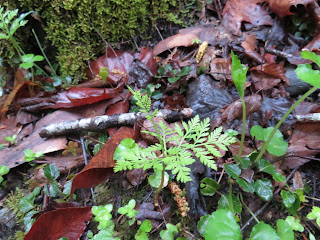Last day of Pilgrimage and it is a fine day indeed. We gather at Newfound Gap and shuttle cars to the Kephart Prong trailhead. Finally, we are underway. We stop alot on the 1.7 mile hike of the AT to Seat Heifer. We learn about Skunk goldenrod whose odor we smell on and off today. We head about the endemic Rugels Ragwort named for famed botanist Ferdinand Rugels. And we saw this school bus lichen above.
After making the turn onto Sweat Heifer, I spot a Ruffed Grouse on the ground. Later we see a brown headed nuthatch.
Whatta burl
Sweat Heifer is another area of rich diversity. Carol Ann and Joey lead the way into the botanical world. We slowly make our way down 2500 feet in elevation, passing unmatched beauty along the way.
A discussion ensues
"Steady, Professor"
Dwarf ginseng
We ran through several areas where Dwarf Ginseng was in flower and in fruit. This is not the highly prized ginseng which is poached from the park to supply demand in China.
Undulatum
Wood Betony
As we reached the shelter which marked the end of the Sweat Heifer Trail, I escaped from the group so I'd be able to put in an appearance at a wedding back in Asheboro.
Fringed Phacelia























































